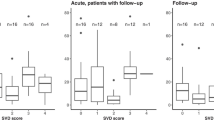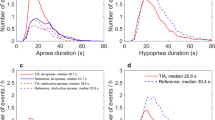Abstract
Objectives
It has been suggested that there is a strong association between sleep-disordered breathing (SDB) and stroke. However, this connection has not been studied in Korean subjects.
Methods
Sixty-one patients with acute cerebral infarction (ACI) and 13 patients with transient ischemic attack (TIA) were consecutively enrolled. SDB was evaluated within 48 h of stroke or TIA onset using a portable screening device, which allowed incidents of apnea, hypopnea, and snoring to be automatically analyzed. Clinical and sleep-related variables, including body mass indices (BMI), cardiovascular risk factors, stroke severity and disability, and Epworth sleepiness scale, Stanford sleepiness scale, and Berlin questionnaire scores were assessed. Sixty-four age-matched patient’s spouses or family members with no history of physician-diagnosed stroke were enrolled as controls.
Results
Mean apnea–hypopnea index (AHI) was significantly higher in TIA (14.6 ± 10.4) and ACI (15.6 ± 14.7) patients than in the controls (7.8 ± 7.0; p = 0.001). The prevalences of SDB were 69.2% in TIA and 50.8% in ACI patients and 32.8% in controls. BMI and systolic blood pressure (SBP) were significantly higher in patients with SDB than in patients without SDB. Sleep-related stroke onset occurred in 17 patients (22.9%), and these patients had significantly higher AHIs. Multiple logistic regression analysis showed that BMI (odds ratio, 1.293; p = 0.027) and SBP (odds ratio, 1.030; p = 0.004) were found to independently predict SDB in patients with TIA or ACI.
Conclusions
SDB is prevalent during the 48 h following ACI or TIA in Korean subjects. The authors recommend that SDB be evaluated after an ACI or TIA, especially in those with a high BMI and an elevated SBP.

Similar content being viewed by others
References
Kripke DF, Ancoli-Israel S, Klauber MR, Wingard DL, Mason WJ, Mullaney DJ (1997) Prevalence of sleep-disordered breathing in ages 40–64 years: a population-based survey. Sleep 20:65–76
Young T, Palta M, Dempsey J, Skatrud J, Weber S, Badr S (1993) The occurrence of sleep-disordered breathing among middle-aged adults. N Engl J Med 328:1230–1235
Ip MS, Lam B, Lauder IJ, Tsang KW, Chung KF, Mok YW, Lam WK (2001) A community study of sleep-disordered breathing in middle-aged Chinese men in Hong Kong. Chest 119:62–69
Kim J, In K, You S, Kang K, Shim J, Lee S, Lee J, Park C, Shin C (2004) Prevalence of sleep-disordered breathing in middle-aged Korean men and women. Am J Respir Crit Care Med 170:1108–1113
Arzt M, Young T, Finn L, Skatrud JB, Bradley TD (2005) Association of sleep-disordered breathing and the occurrence of stroke. Am J Respir Crit Care Med 172:1447–1451
Marshall NS, Wong KK, Liu PY, Cullen SR, Knuiman MW, Grunstein RR (2008) Sleep apnea as an independent risk factor for all-cause mortality: the Busselton Health Study. Sleep 31:1079–1085
Yaggi HK, Concato J, Kernan WN, Lichtman JH, Brass LM, Mohsenin V (2005) Obstructive sleep apnea as a risk factor for stroke and death. N Engl J Med 353:2034–2041
Young T, Finn L, Peppard PE, Szklo-Coxe M, Austin D, Nieto FJ, Stubbs R, Hla KM (2008) Sleep disordered breathing and mortality: eighteen-year follow-up of the Wisconsin sleep cohort. Sleep 31:1071–1078
Yaggi H, Mohsenin V (2004) Obstructive sleep apnoea and stroke. Lancet Neurol 3:333–342
Bassetti C, Aldrich MS (1999) Sleep apnea in acute cerebrovascular diseases: final report on 128 patients. Sleep 22:217–223
Iranzo A, Santamaria J, Berenguer J, Sanchez M, Chamorro A (2002) Prevalence and clinical importance of sleep apnea in the first night after cerebral infarction. Neurology 58:911–916
Turkington PM, Bamford J, Wanklyn P, Elliott MW (2002) Prevalence and predictors of upper airway obstruction in the first 24 hours after acute stroke. Stroke 33:2037–2042
Bassetti CL (2005) Sleep and stroke. Semin Neurol 25:19–32
Neau JP, Paquereau J, Meurice JC, Chavagnat JJ, Gil R (2002) Stroke and sleep apnoea: cause or consequence? Sleep Med Rev 6:457–469
Hui DS, Choy DK, Wong LK, Ko FW, Li TS, Woo J, Kay R (2002) Prevalence of sleep-disordered breathing and continuous positive airway pressure compliance: results in chinese patients with first-ever ischemic stroke. Chest 122:852–860
Adams HP Jr, Bendixen BH, Kappelle LJ, Biller J, Love BB, Gordon DL, Marsh EE III (1993) Classification of subtype of acute ischemic stroke. Definitions for use in a multicenter clinical trial. TOAST. Trial of Org 10172 in Acute Stroke Treatment. Stroke 24:35–41
Brott T, Adams HP Jr, Olinger CP, Marler JR, Barsan WG, Biller J, Spilker J, Holleran R, Eberle R, Hertzberg V et al (1989) Measurements of acute cerebral infarction: a clinical examination scale. Stroke 20:864–870
van Swieten JC, Koudstaal PJ, Visser MC, Schouten HJ, van Gijn J (1988) Interobserver agreement for the assessment of handicap in stroke patients. Stroke 19:604–607
Johns MW (1991) A new method for measuring daytime sleepiness: the Epworth sleepiness scale. Sleep 14:540–545
ZV HE, Smythe H, Phillips R, Dement WC (1973) Qualitification of sleepiness: a new approach. Psychophysiology 10:431–436
Netzer NC, Stoohs RA, Netzer CM, Clark K, Strohl KP (1999) Using the Berlin questionnaire to identify patients at risk for the sleep apnea syndrome. Ann Intern Med 131:485–491
Bearpark H, Elliott L, Grunstein R, Cullen S, Schneider H, Althaus W, Sullivan C (1995) Snoring and sleep apnea. A population study in Australian men. Am J Respir Crit Care Med 151:1459–1465
Chen H, Lowe AA, Bai Y, Hamilton P, Fleetham JA, Almeida FR (2009) Evaluation of a portable recording device (ApneaLinktrade mark) for case selection of obstructive sleep apnea. Sleep Breath 13:213–219
Erman MK, Stewart D, Einhorn D, Gordon N, Casal E (2007) Validation of the ApneaLink for the screening of sleep apnea: a novel and simple single-channel recording device. J Clin Sleep Med 3:387–392
Ng SS, Chan TO, To KW, Ngai J, Tung A, Ko FW, Hui DS (2008) Validation of a Portable Recording Device (ApneaLink) for identifying Patients with Suspected Obstructive Sleep Apnea Syndrome (OSAS). Intern Med J 39(11):757–62
Wang Y, Teschler T, Weinreich G, Hess S, Wessendorf TE, Teschler H (2003) Validation of microMESAM as screening device for sleep disordered breathing. Pneumologie 57:734–740
Bassetti C, Aldrich M (1999) Night time versus daytime transient ischaemic attack and ischaemic stroke: a prospective study of 110 patients. J Neurol Neurosurg Psychiatry 67:463–467
Parra O, Arboix A, Bechich S, Garcia-Eroles L, Montserrat JM, Lopez JA, Ballester E, Guerra JM, Sopena JJ (2000) Time course of sleep-related breathing disorders in first-ever stroke or transient ischemic attack. Am J Respir Crit Care Med 161:375–380
Young T, Peppard P, Palta M, Hla KM, Finn L, Morgan B, Skatrud J (1997) Population-based study of sleep-disordered breathing as a risk factor for hypertension. Arch Intern Med 157:1746–1752
Peppard PE, Young T, Palta M, Dempsey J, Skatrud J (2000) Longitudinal study of moderate weight change and sleep-disordered breathing. JAMA 284:3015–3021
Wolk R, Kara T, Somers VK (2003) Sleep-disordered breathing and cardiovascular disease. Circulation 108:9–12
Peppard PE, Young T, Palta M, Skatrud J (2000) Prospective study of the association between sleep-disordered breathing and hypertension. N Engl J Med 342:1378–1384
Tanigawa T, Tachibana N, Yamagishi K, Muraki I, Kudo M, Ohira T, Kitamura A, Sato S, Shimamoto T, Iso H (2004) Relationship between sleep-disordered breathing and blood pressure levels in community-based samples of Japanese men. Hypertens Res 27:479–484
Dimsdale JE, Loredo JS, Profant J (2000) Effect of continuous positive airway pressure on blood pressure: a placebo trial. Hypertension 35:144–147
Faccenda JF, Mackay TW, Boon NA, Douglas NJ (2001) Randomized placebo-controlled trial of continuous positive airway pressure on blood pressure in the sleep apnea-hypopnea syndrome. Am J Respir Crit Care Med 163:344–348
Nakano H, Tanigawa T, Ohnishi Y, Uemori H, Senzaki K, Furukawa T, Nishima S (2008) Validation of a single-channel airflow monitor for screening of sleep-disordered breathing. Eur Respir J 32:1060–1067
Johns MW (1993) Daytime sleepiness, snoring, and obstructive sleep apnea. The Epworth sleepiness scale. Chest 103:30–36
Weinreich G, Plein K, Teschler T, Resler J, Teschler H (2006) Is the Berlin questionnaire an appropriate diagnostic tool for sleep medicine in pneumological rehabilitation? Pneumologie 60:737–742
Bogousslavsky J, Khurana R, Deruaz JP, Hornung JP, Regli F, Janzer R, Perret C (1990) Respiratory failure and unilateral caudal brainstem infarction. Ann Neurol 28:668–673
Acknowledgments
This study was supported by grant from Korea University (K0814321).
Author information
Authors and Affiliations
Corresponding author
Rights and permissions
About this article
Cite this article
Joo, BE., Seok, H.Y., Yu, SW. et al. Prevalence of sleep-disordered breathing in acute ischemic stroke as determined using a portable sleep apnea monitoring device in Korean subjects. Sleep Breath 15, 77–82 (2011). https://doi.org/10.1007/s11325-009-0325-8
Received:
Revised:
Accepted:
Published:
Issue Date:
DOI: https://doi.org/10.1007/s11325-009-0325-8




